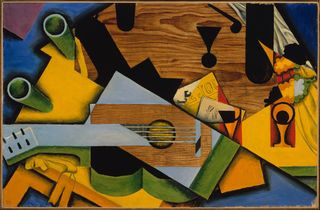For My Health. And Yours.
For My Health. And Yours.
During national creative arts therapy week, thoughts on why we do what we do.
It’s an expression of sarcasm—“I’m doing it for my health”—uttered
usually in a snide tone to communicate the unlikeliest idea imaginable.
Here is the first example that pops up when you search the term on
UrbanDictionary.com:
 This was illuminating. My health has nothing to do with why I sit to
play the guitar, but it is precisely the reason I play the guitar in the
first place—and other instruments, too. It’s why I sing. It’s why I
make music at all. I do it for my health.
This was illuminating. My health has nothing to do with why I sit to
play the guitar, but it is precisely the reason I play the guitar in the
first place—and other instruments, too. It’s why I sing. It’s why I
make music at all. I do it for my health.
I certainly don’t do it for the money. There was a time when I used to perform in public, and occasionally that was paid work. The whole enterprise never made much sense. Unless you’re in the top 1%, trying to make a living in the music business is phenomenally hard. It’s exhausting just to think about it.
The expectation that musicians could support themselves financially is a relatively modern idea, going back a few hundred years. But music-making as a central part of everyday life is pre-historic. The earliest known musical instrument—a bone flute excavated from a cave in Germany—is estimated to be about 35,000 years old. Long before music became a performing arts profession, it was a health practice. Musicking with people as a way to promote good health makes all the sense in the world. (Yes, musicking is a term used by music therapists.)
Research is constantly deepening our understanding of why engaging in the arts benefits our mental and physical health. There are different mechanisms at work within the various creative arts therapies, which include, among others, music therapy, art therapy, and dance/movement therapy. But all of these disciplines benefit from a special marriage of art and science that is becoming more and more sophisticated. Another common feature is that these are young professions built around ancient human activities. And these related fields are also recognized each year during the third week of March, which is National Creative Arts Therapy week.
In my field, I keep track of neuroscience studies that help to explain what might be happening in the brain when, for example, a music therapist enables a Parkinson’s patient to walk steadily. Or when levels of the stress hormone cortisol drop after members of a choir sing together. And before long, I believe we’ll be able to identify with confidence whatever motivated that person to pick up a bone 35,000 years ago and carve it into a flute
“Hey! Why do you sit when you play the guitar?”“It’s for my health.”

Source: Juan Gris, Still Life with Guitar, Public Domain CC0 1.0 Universal (CC0 1.0)
I certainly don’t do it for the money. There was a time when I used to perform in public, and occasionally that was paid work. The whole enterprise never made much sense. Unless you’re in the top 1%, trying to make a living in the music business is phenomenally hard. It’s exhausting just to think about it.
The expectation that musicians could support themselves financially is a relatively modern idea, going back a few hundred years. But music-making as a central part of everyday life is pre-historic. The earliest known musical instrument—a bone flute excavated from a cave in Germany—is estimated to be about 35,000 years old. Long before music became a performing arts profession, it was a health practice. Musicking with people as a way to promote good health makes all the sense in the world. (Yes, musicking is a term used by music therapists.)
Research is constantly deepening our understanding of why engaging in the arts benefits our mental and physical health. There are different mechanisms at work within the various creative arts therapies, which include, among others, music therapy, art therapy, and dance/movement therapy. But all of these disciplines benefit from a special marriage of art and science that is becoming more and more sophisticated. Another common feature is that these are young professions built around ancient human activities. And these related fields are also recognized each year during the third week of March, which is National Creative Arts Therapy week.
In my field, I keep track of neuroscience studies that help to explain what might be happening in the brain when, for example, a music therapist enables a Parkinson’s patient to walk steadily. Or when levels of the stress hormone cortisol drop after members of a choir sing together. And before long, I believe we’ll be able to identify with confidence whatever motivated that person to pick up a bone 35,000 years ago and carve it into a flute

